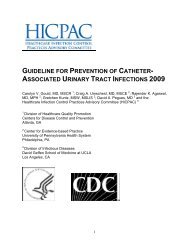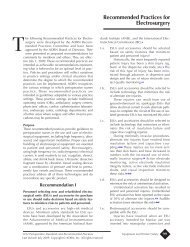sttttttttttttsMy attorney sent a file box filled with medical recordsfor me to review. I was frustrated as I reviewed <strong>the</strong>serecords. Notes were handwritten, difficult to read andfragmented with different discipl<strong>in</strong>es writ<strong>in</strong>g <strong>in</strong> varioussections. Very few notes were made <strong>in</strong> <strong>the</strong> commentsection <strong>of</strong> <strong>the</strong> nurs<strong>in</strong>g notes. Flow sheets were not completed.It was challeng<strong>in</strong>g to determ<strong>in</strong>e if <strong>the</strong> patientactually had been turned, cleansed and repositionedconsistently. Although <strong>the</strong> patient was <strong>in</strong>cont<strong>in</strong>ent <strong>of</strong>stool, <strong>the</strong>re were very few episodes <strong>of</strong> <strong>in</strong>cont<strong>in</strong>encenoted. Even though I remembered that she was placedon a special mattress for pressure redistribution, I wasunable to determ<strong>in</strong>e this fact from <strong>the</strong> chart, despite<strong>the</strong> fact that a special bed was ordered on day eight.The DepositionThe attorney for <strong>the</strong> pla<strong>in</strong>tiff handed me <strong>the</strong> nurses’notes for <strong>the</strong> first seven days <strong>of</strong> <strong>the</strong> patient’shospitalization and asked me to read <strong>the</strong> BradenScore, <strong>the</strong> <strong>in</strong>tegumentary, neuromuscular section,turn<strong>in</strong>g/reposition<strong>in</strong>g section <strong>of</strong> <strong>the</strong> flow sheet and<strong>the</strong> nurses’ comment section. There was very littlecharted <strong>in</strong> any <strong>of</strong> <strong>the</strong> sections. The Braden Scoreshowed <strong>the</strong> patient to be at high risk for pressureulcer development. I was unable to f<strong>in</strong>d a plan <strong>of</strong>care <strong>in</strong> any <strong>of</strong> <strong>the</strong> files. Although <strong>the</strong> hospital hadjust implemented a new pressure ulcer program,none <strong>of</strong> <strong>the</strong> new forms or <strong>the</strong> pressure ulcer trend<strong>in</strong>gwere filled out. The attorney had me go through<strong>the</strong> chart look<strong>in</strong>g for documentation <strong>of</strong> <strong>in</strong>stances<strong>of</strong> patient non-adherence. I was stunned at <strong>the</strong> lack<strong>of</strong> documentation by both physicians and nursesabout her behavior, <strong>the</strong> sk<strong>in</strong> and <strong>the</strong> pressure ulcerthroughout her hospitalization.The oppos<strong>in</strong>g counsel had me read my own chart<strong>in</strong>gfor <strong>the</strong> times I had <strong>in</strong>teracted with <strong>the</strong> patient andasked if <strong>the</strong> doctor had been <strong>in</strong>formed consistentlyregard<strong>in</strong>g <strong>the</strong> sk<strong>in</strong> changes and wound management<strong>of</strong> <strong>the</strong> pressure ulcer. I was embarrassed with myown chart<strong>in</strong>g and lack <strong>of</strong> <strong>in</strong>formation charted. Thephotographs taken throughout her hospitalizationwere not labeled properly and were out <strong>of</strong> sequence.There were no follow-up notes to <strong>in</strong>dicate <strong>the</strong> patientor family received education about pressure ulcerprevention or treatment. There also was no dischargenote detail<strong>in</strong>g <strong>the</strong> pressure ulcer o<strong>the</strong>r than <strong>the</strong> orderto cont<strong>in</strong>ue negative <strong>the</strong>rapy.Lessons LearnedSome <strong>of</strong> <strong>the</strong> common compla<strong>in</strong>ts registered aga<strong>in</strong>stnurses <strong>in</strong> a lawsuit are failure to follow a standard<strong>of</strong> care, failure to communicate, failure to assess andmonitor appropriately, failure to report significantf<strong>in</strong>d<strong>in</strong>gs, failure to act as a patient advocate andfailure to document. That certa<strong>in</strong>ly applies <strong>in</strong> thiscase. Documentation is essential! Here are <strong>the</strong> ma<strong>in</strong>lessons I learned from this experience:• On admission, it is important for <strong>the</strong> woundcare specialist to assess <strong>the</strong> patient’s sk<strong>in</strong> andwound and write a detailed, <strong>in</strong>itial, focusedassessment. If a wound is present on admission,document <strong>the</strong> wound pr<strong>of</strong>ile.• Document <strong>the</strong> type <strong>of</strong> support surface <strong>the</strong>patient is on or whenever a support systemchange is ordered.• Take a clear photograph <strong>of</strong> <strong>the</strong> wound accord<strong>in</strong>gto your organization’s guidel<strong>in</strong>es. For me, thatwould mean us<strong>in</strong>g a measurement label and ablack mark<strong>in</strong>g pen to clearly identify <strong>the</strong> patient’sname or <strong>in</strong>itials, medical record number, dateand location <strong>of</strong> <strong>the</strong> wound on <strong>the</strong> photo.• Review and follow <strong>the</strong> guidel<strong>in</strong>es relatedto sk<strong>in</strong> and wound care.• Label and place <strong>the</strong> prevention protocolstand<strong>in</strong>g orders and, if a wound is present,<strong>the</strong> wound and sk<strong>in</strong> care treatment stand<strong>in</strong>gorders. Complete <strong>the</strong> required sections and sign.• Notify <strong>the</strong> physician regard<strong>in</strong>g <strong>the</strong> sk<strong>in</strong>/wound condition. Based on your f<strong>in</strong>d<strong>in</strong>gs,document if <strong>the</strong> wound is healable ornon-healable and document <strong>the</strong> <strong>in</strong>terventionsfor prevention and treatment <strong>of</strong> <strong>the</strong> sk<strong>in</strong>/wound.• Make sure you do a follow-up note.• Record <strong>in</strong> <strong>the</strong> discharge note <strong>the</strong> sk<strong>in</strong>and wound status.• Remember <strong>the</strong> power <strong>of</strong> words. Payattention to “words not to use.”After a few months, <strong>the</strong> case was settled out <strong>of</strong> court <strong>in</strong> favor <strong>of</strong> <strong>the</strong> patient.I hope by my shar<strong>in</strong>g my own story <strong>of</strong> do<strong>in</strong>g a deposition, you will ga<strong>in</strong> from my pa<strong>in</strong>!stttttttttttts<strong>Legal</strong> <strong>Issues</strong> <strong>in</strong> <strong>the</strong> <strong>Care</strong> <strong>of</strong> <strong>Pressure</strong> <strong>Ulcer</strong>s: Key Concepts for Healthcare Providers22
References1 Russo, CA, Ste<strong>in</strong>er C, Spector W. Hospitalizations related to pressure ulcers 2006. HCUP Statistical Brief #64. December 2008. Agency forHealthcare Research and Quality, Rockville, MD. Available at http://www.hcup-us.ahrq.gov/reports/statbriefs/sb64.pdf. Accessed March 31, 2009.2 Dramatic changes <strong>in</strong> U.S. ag<strong>in</strong>g highlighted <strong>in</strong> new census, NIH report. Press release. U.S. National Institutes <strong>of</strong> Health, National Instituteon Ag<strong>in</strong>g. Available at http://www.nia.nih.gov/NewsAndEvents/PressReleases/PR2006030965PlusReport.htm. Accessed March 26, 2009.3 Hospital-acquired conditions (HAC) and Hospital Outpatient Healthcare-Associated Conditions (HOP-HAC) listen<strong>in</strong>g session. Transcript,December 18, 2008.4 Centers for Medicare & Medicaid Services. Medicare Program; Proposed Changes to <strong>the</strong> Hospital Inpatient Prospective Payment Systems andFiscal Year 2009 Rates; Proposed Changes to Disclosure <strong>of</strong> Physician Ownership <strong>in</strong> Hospitals and Physician Self-Referral Rules; ProposedCollection <strong>of</strong> Information Regard<strong>in</strong>g F<strong>in</strong>ancial Relationships Between Hospitals and Physicians; Proposed Rule. Federal Register.2008;73(84):23550. Available at: http://edocket.access.gpo.gov/2008/pdf/08-1135.pdf. Accessed April 6, 2009.5 Reddy M, Gill SS, Rochon PA. Prevent<strong>in</strong>g pressure ulcers: a systematic review. JAMA. 2006;296:974-984.6 Armstrong DG, Ayello EA, Capitulo KL, et al. New opportunities to improve pressure ulcer prevention and treatment: implications<strong>of</strong> <strong>the</strong> CMS <strong>in</strong>patient hospital care present on admission (POA) <strong>in</strong>dicators/hospital-acquired conditions (HAC) policy. J WoundOstomy Cont<strong>in</strong>ence Nurs<strong>in</strong>g. 2008;35(5):485-492.7 Ayello EA, Lyder CH. A new era <strong>of</strong> pressure ulcer accountability <strong>in</strong> acute care. Advances <strong>in</strong> Sk<strong>in</strong> & Wound <strong>Care</strong>. 2008;21:134-42.8 Gibbons W, Shanks HT, Kle<strong>in</strong>helter P, Jones P. Elim<strong>in</strong>at<strong>in</strong>g facility-acquired pressure ulcers at Ascension Health. Jt Comm J Qual Patient Saf.2006;32:488-496.9 Centers for Medicare & Medicaid Services. Hospital-Acquired Conditions (Present on Admission Indicator) Web page.Available at http://www.cms.hhs.gov/HospitalAcqCond/07_EducationalResources.asp#TopOfPage. Accessed April 1, 2009.10 Federal Register, Part II, Department <strong>of</strong> Health and Human Services. 42 CFR Parts 411, 412, 413 and 489 Medicare Program; Proposed Changesto <strong>the</strong> Hospital Inpatient Prospective Payment Systems and Fiscal Year 2008 Rates, Proposed Rule. May 3, 2007. 72:24720.11 Voss AC, Bender SA, Ferguson ML et al. Long-term care liability for pressure ulcers. J Am Geriatric Soc. 2005;53:1587-92.12 Centers for Medicare & Medicaid Services. Present on admission (POA) <strong>in</strong>dicator report<strong>in</strong>g. Available at http://www.cms.hhs.gov/HospitalAcqCond/Downloads/poa_fact_sheet.pdf. Accessed April 1, 2009.13 Odierna E, Zeleznik J. <strong>Pressure</strong> ulcer education: a pilot study <strong>of</strong> <strong>the</strong> knowledge and cl<strong>in</strong>ical confidence <strong>of</strong> geriatric fellows.Adv Sk<strong>in</strong> Wound <strong>Care</strong>. 2003;16:26-30.14 Sibbald RG, Krasner DL, Lutz JB, et al. The SCALE Expert Panel: Sk<strong>in</strong> Changes at Life’s End. Prelim<strong>in</strong>ary Consensus Document.September 2008. Available at: http://www.gaymar.com.15 Centers for Medicare & Medicaid Services. Tag F314. Available at http://www.cms.hhs.gov/transmittals/downloads/R22SOMA.pdf.Accessed January 27, 2009.16 Centers for Medicare & Medicaid Services. Medicare Program; Changes to <strong>the</strong> Hospital Inpatient Prospective Payment Systems and Fiscal Year2008 Rates. Available at http://www.cms.hhs.gov/Acute<strong>in</strong>patientPPS/downloads/CMS-1533-FC.pdf. Accessed April 10, 2009.17 H.R. 1, The American Recovery and Re<strong>in</strong>vestment Act <strong>of</strong> 2009.18 March 3, 2008. The Department <strong>of</strong> Health and Senior Services published <strong>in</strong> <strong>the</strong> New Jersey Register (40N.J.R. 1094(a)) f<strong>in</strong>al rules implement<strong>in</strong>g<strong>the</strong> Patient Safety Act (n.J.S.A.26:2H-12.23to12.25). http://www.njha.com/LibrarySection/pdf/Patient_Safety_Regulations.19 Haig KM, Sutton S, Whill<strong>in</strong>gton J. SBAR: A shared mental model for improv<strong>in</strong>g communication between cl<strong>in</strong>icians.Jt Comm J Qual Pat Saf. 2006;32:167-75.20 Braden B, Bergstrom N. The Braden Scale. Available at http://www.bradenscale.com/braden.PDF. Accessed January 27, 2009.21 Kr<strong>in</strong>g DL. Reliability and validity <strong>of</strong> <strong>the</strong> Braden Scale for predict<strong>in</strong>g pressure ulcer risk. J Wound Ostomy Cont<strong>in</strong>ence Nurs. 2007;34:399-406.22 Kottner J, Dassen T. An <strong>in</strong>terrater reliability study <strong>of</strong> <strong>the</strong> Braden scale <strong>in</strong> two nurs<strong>in</strong>g homes. Int J Nurs Stud. 2008;45:1501-11.23 Soloway DN. Civil claims relat<strong>in</strong>g to pressure ulcers: a claimant’s lawyer’s perspective. Ostomy Wound Manage. 1998;44:20-4, 26.24 Brown, G. Wound documentation: Manag<strong>in</strong>g risk. ASWC. 2006;19(3)155-165;quiz 166-167.25 Rennert R, Gol<strong>in</strong>ko M, Yan A, Flattau A, Tomic-Canic M, Brem H. Develop<strong>in</strong>g and evaluat<strong>in</strong>g outcomes <strong>of</strong> an evidence-based protocol for <strong>the</strong>treatment <strong>of</strong> osteomyelitis <strong>in</strong> stage IV pressure ulcers: a literature and wound electronic medical record database review. Ostomy Wound Manage.2009;55(3):42-53.26 Gol<strong>in</strong>ko MS, Clark S, Rennert R, Flattau A, Boulton AJ, Brem H. Wound emergencies: <strong>the</strong> importance <strong>of</strong> assessment, documentation and earlytreatment us<strong>in</strong>g a wound electronic medical record. Ostomy Wound Manage. 2009;55(5):54-61.27 Photography FAQ. National <strong>Pressure</strong> <strong>Ulcer</strong> Advisory Panel. Available at www.npuap.org/DOCS/PhotographyFaq.dochttp://www.npuap.org/DOCS/PhotographyFaq.doc. Accessed on April 1, 200928 Photography <strong>in</strong> wound documentation. Available at http://www.wocn.org/pdfs/WOCN_Library/Position_Statements/photoposition.pdf.Accessed April 10, 2009.29 Ahn C, Salcido RS. Advances <strong>in</strong> wound photography and assessment methods. Adv Sk<strong>in</strong> Wound <strong>Care</strong>. 2008;21(2):85-93.30 Rennert R, Gol<strong>in</strong>ko M, Kaplan D et al. Standardization <strong>of</strong> wound photography us<strong>in</strong>g <strong>the</strong> wound electronic medical record. Adv Sk<strong>in</strong> Wound <strong>Care</strong>.2009;22(1):32-38.31 Sullivan, V. In focus: The photography forecast. Today’s Wound Cl<strong>in</strong>ic. 2008;2(2):30-31,33.32 NPUAP <strong>Pressure</strong> <strong>Ulcer</strong> Guidel<strong>in</strong>es. 1988.33 National <strong>Pressure</strong> <strong>Ulcer</strong> Advisory Panel. <strong>Pressure</strong> <strong>Ulcer</strong> Stages Revised by NPUAP. Available at http://www.npuap.org/pr2.htm.Accessed June 22, 2009.34 Gefen A. deep tissue <strong>in</strong>jury from a bioeng<strong>in</strong>eer<strong>in</strong>g po<strong>in</strong>t <strong>of</strong> view. Ostomy Wound Manage. 2009;55(4):26-36.35 Centers for Medicare & Medicaid Services. Medicare Program; Proposed Changes to <strong>the</strong> Hospital Inpatient Prospective PaymentSystems and Fiscal Year 2009 Rates; Selection Criteria for HACs, Reasonably Preventable, Federal Register. 2008;73(84):23549.Available at: http://edocket.access.gpo.gov/2008/pdf/08-1135.pdf. Accessed April 10, 2009.36 Sibbald RG, Alavi A, Sibbald M, Sibbald D, Rath D, Davis D. Effective adult education pr<strong>in</strong>ciples to improve outcomes <strong>in</strong> patients with chronicwounds. In: Krasner DL, Rodeheaver GT, Sibbald RG, Eds. Chronic Wound <strong>Care</strong>: A Cl<strong>in</strong>ical Source Book for Healthcare Pr<strong>of</strong>essionals. 4th ed.Malvern, Pa; HMP Communications, 2007:29-43.37 New Jersey Hospital Association Web site. Quality, Patient Safety and Cl<strong>in</strong>ical Affairs. NJHA Institute for Quality and Patient Safety. For <strong>Pressure</strong><strong>Ulcer</strong> Collaborative Members. Available at http://www.njha.com/quality<strong>in</strong>stitute/ulcer.aspx. Accessed April 10, 2009.38 Institute for Healthcare Improvement Web site. Gett<strong>in</strong>g Started Kit: Prevent<strong>in</strong>g <strong>Pressure</strong> <strong>Ulcer</strong>s How-To Guide. Available athttp://www.ihi.org/IHI/Topics/PatientSafety/SafetyGeneral/improvementStories/FSRelieve<strong>the</strong><strong>Pressure</strong>andReduceHarm.htm.Accessed April 10, 2009.23
















